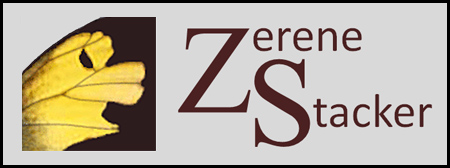Options > Preferences > Image Saving
This panel combines two sorts of specifications.
The top section, titled File Saving Parameters, controls the format of files when they are saved via File > Save Output Image(s).
- file type (JPEG or TIFF)
- compression quality (only for JPEG)
- pixel depth (8 bits RGB or 16 bits RGB, only for TIFF)
The option to “Retain full dynamic range” controls how PMax outputs are saved. The default, with no checkmark on “Retain full dynamic range”, is to save files as they appear on screen. This preserves whatever contrast and brightness the PMax method naturally produces, but it may cause unwanted clipping at black and white if the source files reach near those limits and PMax's intrinsic contrast enhancement pushes them past the limits. Placing a checkmark on “Retain full dynamic range” causes the image's brightness and contrast to be adjusted if necessary to assure that no information is lost by clipping. The resulting image is likely to appear washed out, in which case it will require further levels or curves adjustment to restore whatever appearance you prefer. To get the best results, files saved with “Retain full dynamic range” should be formatted as 16-bit TIFF so that adjustments can be made without introducing posterization artifacts.
The bottom section, titled Output Image Names, provides a template that controls how Zerene Stacker names output images as they are created and placed into the Output Images list.
By default, the output naming template is set to “{datetime} ZS {method}”, which produces names like “2011-04-23-15.37.40 ZS PMax”. However, you can redefine the template to use any combination of certain {tagnames} surrounded by curly braces, as follows.
Note: To work properly, the tagnames must be surrounded by curly braces {} and not by ordinary parentheses (). These characters look very much alike in certain fonts, so be sure to type carefully.
- {datetime} date and time (in fixed format: YYYY-MM-dd-hh.mm.ss)
- {datetime:format} date and/or time in variable format, as described HERE. For example the default {datetime} tag is equivalent to {datetime:YYYY-MM-dd-hh.mm.ss}
- {method} either “PMax” or “DMap”
- {outseq} output sequence number, counted from project creation.
- {outseq:#} like {outseq}, but formatted to include the specified number of digits. For example {outseq:2} when the sequence number is 5 will produce “05” rather than just “5”.
- {mininp} shortest unique minimum number that appears in the names of source frames used for this output. If the image was constructed from input files named IMG_9713 through IMG_9765, then {mininp} will be “13”. The file name extension such as “.JPG” or “.TIF” is always ignored.
- {mininp:#} like {mininp}, except that at most only # characters will be truncated from the full file names. If the image was constructed from input files named IMG_9713 through IMG_9765, then {mininp:2} will be “G_9713” instead of just “13”. In most cases, {mininp:0} will be the entire name of the first file, “IMG_9713”. However, if every one of the input file names has the same string of characters on its trailing end (a “common suffix”), then that string will always be deleted. For example, {mininp:0} of IMG_0001_RustyNail.JPG through IMG_0016_RustyNail.JPG will be simply IMG_0001. At this time there is no way to force a common suffix to be retained.
- {maxinp} similar to {mininp}, except the maximum number. Note that maxinp does not accept a :#chars argument. Instead, {maxinp} inherits the argument from {mininp}, if there is one. Also note that {mininp} and {maxinp} are designed to work with numbers that have been zero-filled to a constant length, for example “Image-001” through “Image-247” and not “Image-1” through 'Image-247“.
- {sourcefolder} name of the folder that contains the first image in the Input Files list, when the stacking operation is completed.
- {fntodot} file name of first file selected, to first dot
- {estrad} estimation radius, for DMap only
- {ERlab} equivalent to ”,ER={estrad}“ if DMap was run, but nothing otherwise.
- {smoothrad} smoothing radius, for DMap only
- {SRlab} equivalent to ”,SR={smoothrad}“ if DMap was run, but nothing otherwise.
- {CTPCTlab} produces ”,CTPCT=<contrast threshold percentile>“ if DMap was run, but nothing otherwise.
- {CTLEVlab} produces ”,CTLEV=<contrast threshold level>“ if DMap was run, but nothing otherwise.
- {XS} X-Shift selected, from alignment control, expressed as “true” or “false”.
- {XSPCT} X-Shift percent, from alignment control.
- {XSPCTlab} equivalent to ”,XSPCT=<value>“ if X-Shift is selected, but nothing otherwise.
- {YS} Y-Shift selected, from alignment control, expressed as “true” or “false”.
- {YSPCT} Y-Shift percent, from alignment control.
- {YSPCTlab} equivalent to ”,YSPCT=<value>“ if Y-Shift is selected, but nothing otherwise.
- {RO} Rotation selected, from alignment control.
- {RODEG} Rotation limit in degrees, from alignment control.
- {RODEGlab} equivalent to ”,RODEG=<value>“ if rotation is selected, but nothing otherwise.
- {CB} Brightness selected, from alignment control (CB = Contrast/Brightness).
- {CBlab} equivalent to ”,CB=true“ if brightness is selected, but nothing otherwise.
- {SC} Scaling selected, from alignment control.
- {SClab} equivalent to ”,SC=true“ if scaling is selected, but nothing otherwise.
- {FSF} Frame Skip Factor, from “Stack every N'th frame”.
- {FSFlab} equivalent to ”,FSF=<value>“ if “Stack every N'th frame” is selected, but nothing otherwise.
- {numinp} number of input files selected for the stacking operation
Examples:
- The template {method} {mininp:4}-{maxinp} will produce output image names like “PMax 9651-9712”.
- The template {method}{ERlab}{SRlab} will product output image names like “DMap,ER=5,SR=2” or “PMax”.
- The template {mininp:0}-{maxinp}_{method} will produce output image names like “IMG_9651-IMG_9712_PMax”.
If the generated name is not unique, then a dash and a number will be appended to force uniqueness.

